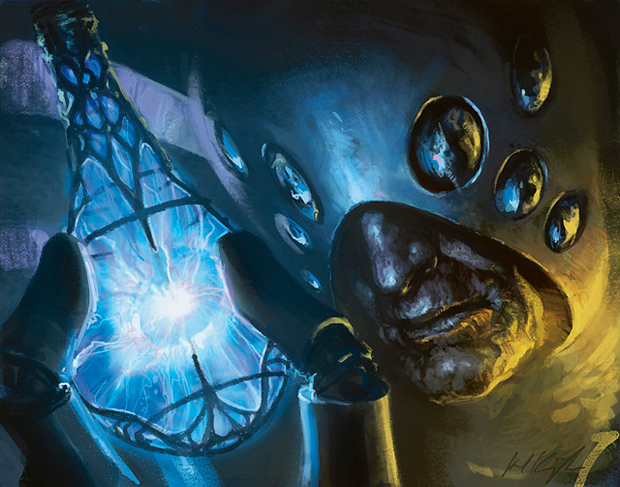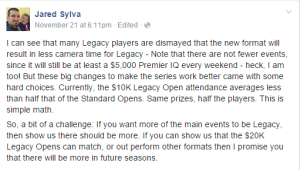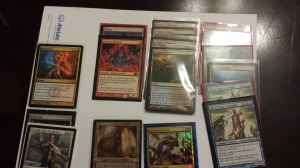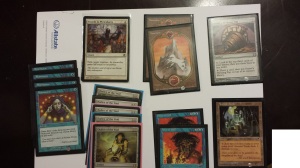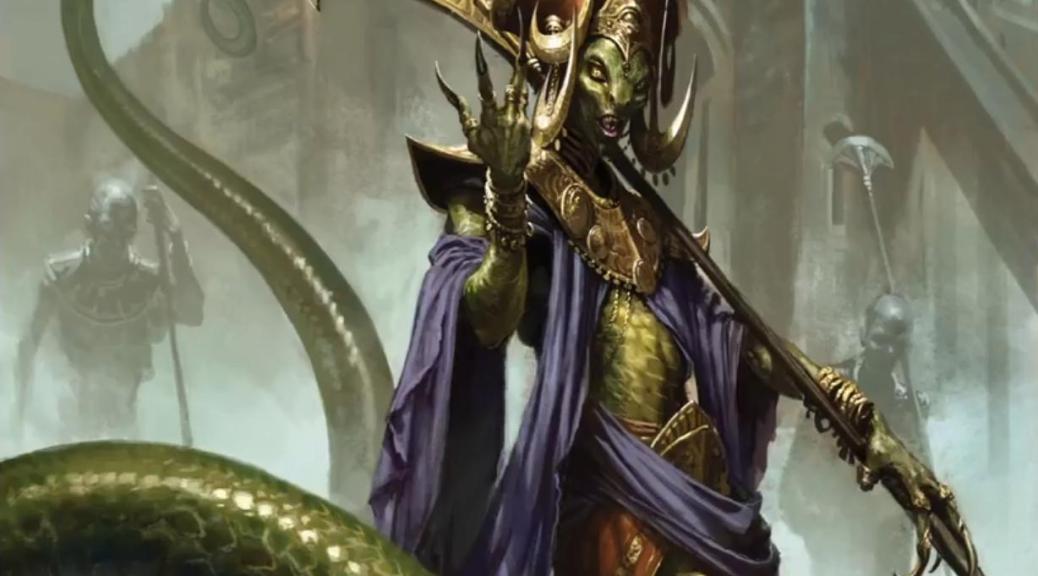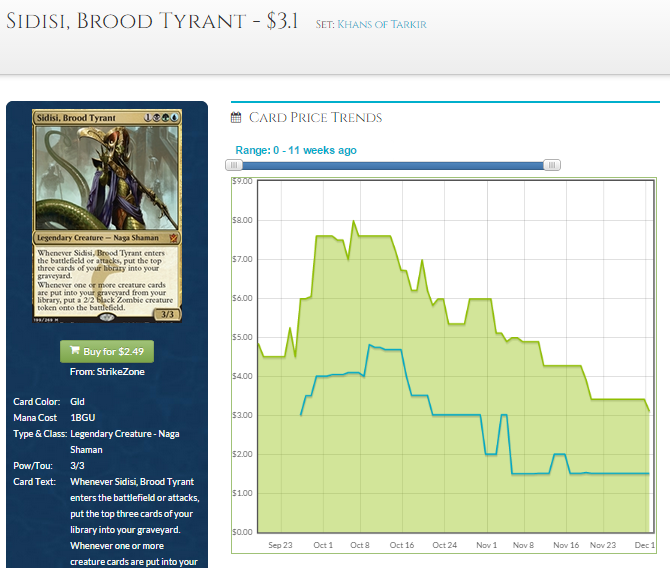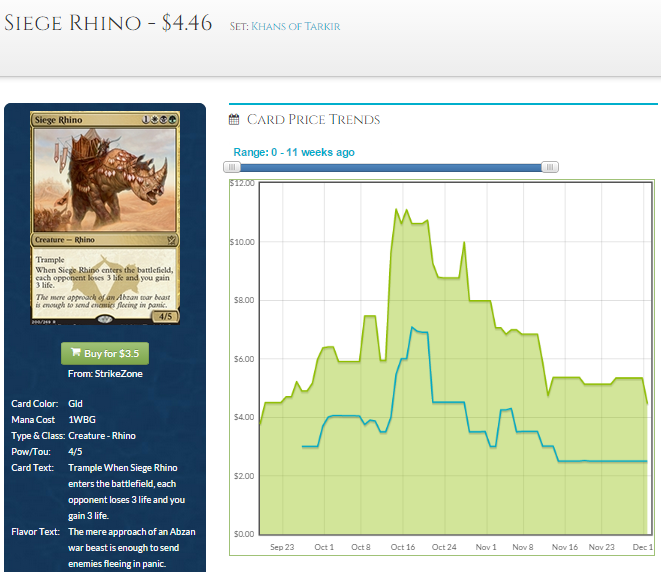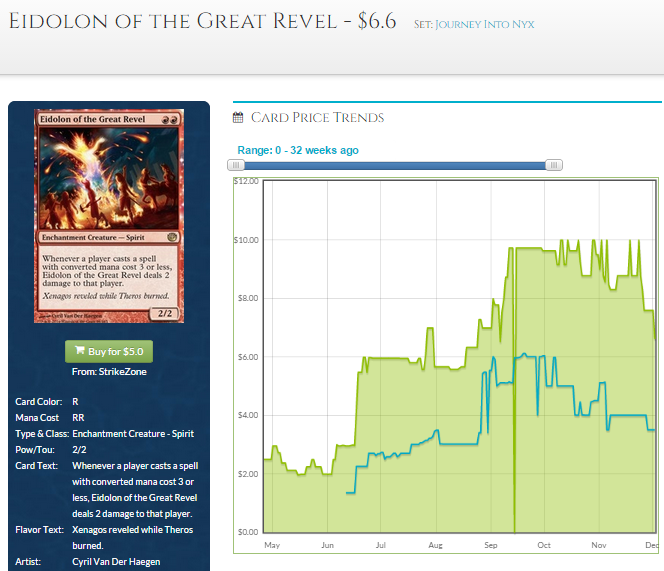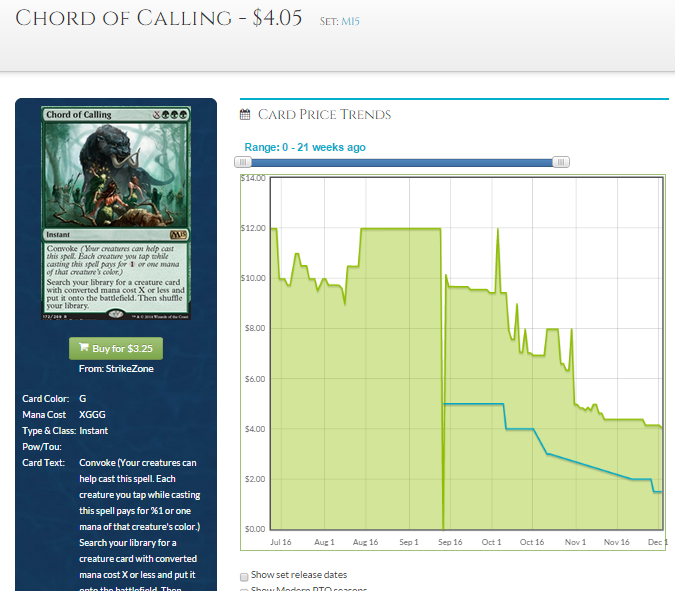By: Jared Yost
For the Modern fans among us, I feel like it’s time to give some serious thought to the upcoming Modern Masters II now that Khans has been out for a few months. Gathering inspiration from some of the awesome deck’s I’ve been seeing last week at the Magic World Championships, I’ve decided to see what Modern looks like now that Khans has been in the format for several months. Knowing where the format is heading will be important in determining what cards have the highest chance of being in MM2.
Modern Masters Two will not only reduce prices, thereby allowing newer players to more easily enter the format, but it will also provide us with opportunities for picking up previously expensive casual and Commander cards that just happened to be included in the set because someone at Wizards R&D really liked them. Thinking about them now will give us plenty of time to consider whether or not we would like to trade them or buylist them for other potential value cards.
Current Day Values
Let’s see what the most current price swings for cards over the last week have been in Modern according to MTGPrice’s 50 Biggest Gainers of the Week.
Chalice of the Void is the clear winner. Treasure Cruise has arguably done the most damage in Modern than any other format. For now though, many players are fighting through all the TC decks with their cheap cantrips by maindecking or sideboarding Chalice of the Void. Chalice for one charge counter stops a large majority of the spells and will slow them down considerably.
I think the boat has passed on Chalice of the Void for now due to the recent spike. It has spiked to $15 TCG Median and will be sitting there for quite some time – at least until Treasure Cruise is banned. (maybe?)
Another notable high up on the list is Phyrexian Obliterator, which seems to still be hovering around the $30 threshold. It spiked to $30 back in January of this year and hasn’t moved since then. It is played in Modern but isn’t a staple of the format like Tarmogoyf or Dark Confidant. This leads me to believe that the majority of its demand comes from the casual crowd. Casuals love the effect of this horror which makes it seem like a good pickup. The price could easily spike again January of 2015 since it hasn’t moved for a year.
Now that we know which cards seem to be trending upwards in value, let’s take a look at the current metagame and most played cards.
Current Metagame and Most Played Cards
The MTGTop8 recorded metagame over the last two months includes the following:
| Aggro | # |
| UR Aggro | 72 |
| Red Deck Wins | 33 |
| Affinity | 25 |
| Hatebear | 13 |
| Aura Hexproof | 12 |
| Zoo | 11 |
| Merfolk | 8 |
| Junk | 8 |
| RUG Aggro | 5 |
| Jund | 3 |
| Boremandos | 2 |
| Loam | 2 |
| Tokens | 1 |
| Other – Aggro | 1 |
| Control | |
| UWx Midrange | 12 |
| UrzaTron | 10 |
| Valakut | 6 |
| Martyr Life | 5 |
| Blue Moon | 5 |
| UW Control | 4 |
| Gift Control | 2 |
| The Rock | 1 |
| Faeries | 1 |
| Other – Control | 6 |
| Combo | |
| Birthing Pod | 38 |
| Scapeshift | 25 |
| Twin Exarch | 16 |
| Bloom Titan | 7 |
| Jeskai Ascendancy | 7 |
| UR Storm | 5 |
| Ad Nauseam | 4 |
| Infect | 2 |
| Living End | 1 |
| Instant Reanimator | 1 |
| Other – Combo | 1 |
UR Aggro has become the most dominant deck in the format, representing 20% of the Top 8 appearances. UWx is still the most popular control deck and Birthing Pod is still the most popular combo deck through Khans.
Scapeshift has started outpacing Twin Exarch lists as a favorite combo choice since it is much harder to disrupt land drops than creatures in order to execute your instant-win combo. Jeskai Ascendency has become a successful deck in Modern but it is not quite as dominant as everyone thought it would become.
One deck that is falling out of favor is UrzaTron, due to the speed of the UR Aggro decks in the format. Martyr Life seems to be a deck that is taking its place since gaining a huge amount of life in addition will help outpace all of the UR and Burn decks floating around.
Another deck falling out of favor is Living End. With only one Top 8 placement in the last two months, it appears that Living End is falling out of favor for the faster combo decks.
What Does It All Mean?
After reviewing both MTGPrice’s 50 Biggest Gainers of the Week and the MTG Top 8 results over the last two months, I would like to make some observations about several of the cards identified in the first section that I think have a surprising price. In addition, I would like to address the more expensive parts of the decks in the MTG Top 8 results that did not appear in the recently trending cards. My thoughts pertain to the non-foil version of the card for all cases.
| Card | MM2 Possible Inclusion? | Reasoning | Price Thoughts |
| Chalice of the Void | No | Reprint in first MM | Price is inflated due to Treasure Cruise metagame shift. A banning of TC will make Chalice drop again. If you didn’t get in before the spike, then you missed the boat for profit. Only pickup now if you plan on playing Modern in the near future. |
| Phyrexian Obliterator | Yes | Casual favorite, Some Modern play | Expensive, but could spike again before MM2. Pick up your copies before January if you plan on playing with Obliterator in the near future – otherwise wait to see if it is in MM2. |
| Arid Mesa (and other ZEN fetchlands) | Yes | Modern staple, no reprint yet. | The prices of the ZEN fetches have dropped considerably upon Khans fetches being released. They will drop even more if a MM2 reprint happens. I would wait on picking up ZEN fetches unless you need them right away. |
| Aether Vial | No | Reprint in first MM | Aether Vial seems to be trending upwards yet does receive a reprint every now and then. I think Vial will continue to trend upwards until the next reprint, whenever that may come. |
| Cascade Bluffs (and other SHM filter lands) | No | As a set of ten two-color filter lands, this cycle would be better off reprinted across another block like the shocklands were reprinted in RTR block. | Prices for these lands are waaaaay overinflated. Once these are reprinted they are going to bottom out hard. I would not pick up copies of these at all unless you need them for a deck. |
| Smash to Smithereens | Yes | Common, easy to include and is used heavily in Modern against affinity and other artifact based decks. | Price will drop hard once the card is reprinted and it doesn’t have much room to move up. Get rid of any extra copies you have. |
| Mox Opal | Yes | Affinity staple. | Price will drop, but not considerably. Still be wary of holding onto Mox Opals through next summer. |
| Ensnaring Bridge | Yes | Hard to find. Played in Commander, Modern, and Legacy. Casuals also love this card. | Price will drop with a reprint. However, in the long run the price will go up over time until the next reprint. Wait for the bottom and then pick them up. |
| Steam Vents (and other RTR / GTC shocklands) | No | Just reprinted in recent block. Wizards even added extras to the market by including them in Dragon’s Maze. | Pick up shocklands now before their price starts creeping back up again once they become harder to find. I would target blue lands especially. |
| Minamo, School at Water’s Edge | No | Kamigawa legendary lands are sometimes seen in Modern (Eiganjo is one example) but are played a ton in Commander. I’d expect these lands in a Commander product. | Not something I would look to pick up. The card is not going to $20+ anytime soon and if reprinted next year will drop like a rock. |
| Sorin Markov | No | Two printings already, mainly just a casual card. | Sorin is at $15 and climbing. I don’t think he will be reprinted in MM2 but could definitely be reprinted in a Commander or casual supplementary product. |
| Quicksilver Amulet | No | Two printings already, mainly just a casual card. | Similar to Sorin, could easily be put in a supplementary product and is not doubling up any time soon. |
| Rhys the Redeemed | Yes | Only one printing and lots of casual love. | $18 is very high for Rhys. He is worth almost as much as Doubling Season, which is saying something. The price is propped up by scarcity alone. One reprint will crash it. |
| Extraplanar Lens | Yes | Only one printing and lots of casual love. | I would expect Wizards to skip EL over other cards for MM2 but this could be a last minute include since they did not include it in the recent C14 decks. Price will crash if a reprint happens. |
| Akroma’s Memorial | No | Two printings already, mainly a casual card. | Akroma’s Memorial will keep rising over time until the next reprint. I don’t think this reprint will be in MM2. |
| Glimpse the Unthinkable | Yes | Popular casual card with some Modern appeal for a mill deck. Only one printing. | Glimpse is a card that a ton of players love that has yet to see a reprint. MM2 is a great place for it. Price will crash when this happens since it is mainly just a casual card. |
| Deathbringer Liege | No | Popular casual card yet Wizards has found ways outside of MM sets to reprint these (C13, Planechase 2012, etc.) | Lords are popular casual cards but I don’t see this one being printed in a MM set for the reasons I stated. The price will go up over time for this liege without a reprint, though I do expect a commander release to contain this or another liege next year. |
| Elvish Piper | No | Six reprints already. Can find another place outside MM set. | Price will continue to go up until the next reprint. Last reprint was 10th edition, so it has been quite a while since Piper has had a reprint. Maybe the next commander set? |
| Voidslime | Yes | Only one regular reprinting (Champs was full art). Like Glimpse the Unthinkable its a popular casual card, even if not really played in Modern. | I don’t think this card has much room to grow. Only casually popular. If included in Modern Masters the price will drop. |
| Young PyromancerSerum VisionsGitaxian Probe
Forked Bolt Inquisition of Kozilek Remand Spell Pierce |
Yes | I’m including all these cards in the same category because I feel that they are uncommons and commons that could easily get reprinted. They are overvalued in price due to being scarce. | Though not all of these uncommons / commons could be printed, I would expect a large majority of them to be on the list for MM2. I will be getting rid of any extra copies of these I have before next summer (except maybe Young Pyromancer because that is one hot uncommon!). |
| Goblin Guide | Yes | Hugely popular card, both casually and in Modern. | Guide will drop significantly if printed in MM2. Will continue to increase in price until reprint is announced. |
| Eidolon of the Great Revel | No | Standard legal card, no reason. | They could still include Eidolon in an event deck or other supplementary product. The price will continue to go up slowly until then. |
| Noble Hierarch | Yes | Very costly pricewise. Important piece of mana fixing and tempo in Modern and Legacy. High probability of being in MM2. | Hierarch doesn’t have much room to grow, only because most are speculating a reprint in MM2. I would trade away any extra copies you have because the risk is far greater holding. |
| Daybreak CoronetAven Mindcensor | Yes | Random future sight rare with one printing that is amazing in Modern. Commander also likes this card. | Like Hierarch, Daybreak Coronet would not be worth nearly as much if not for being in an older, less printed set. Aven Mindcensor is in the same camp. |
| Geist of Saint Traft | Yes | Popular casual, Commander, and Modern card. | I think Geist has a fair chance of being reprinted as a mythic in MM2, especially if Treasure Cruise is not banned. Very powerful, efficient beater. |
| Snapcaster Mage | Yes | Multi-format all star with only one printing. | Like Goyf and Bob, Snappy will probably be a mythic in MM2 to not kill the price. Should stabilize Snapcaster if this happens. |
| Restoration Angel | Yes | Efficient Modern beater, casual fan favorite being an Angel. | Resto-Angel has a decent chance of being in MM2. If not MM2, then certainly a commander product in the future. |
| Karn Liberated Grove of the Burnwillows |
Yes | Karn is way pricy for a planeswalker, only due to being in NPH. Grove is similarly expensive though played in more than one Modern deck. Both need another reprint to reduce prices. | Both cards will continue to increase in price, but not substantially. Again, risk is way too high to hold extra copies. |
| Mythic Eldrazi (Emrakul, Kozilek, Ulamog) | Yes? | MM2 is a great place for the Eldrazi as a mythic rare cycle. Also, they are casual favorites like many cards on this list. | Slowly going up, but reprint fear will keep prices stabilized for some time. |
| Ranger of EosSerra Ascendant | Yes | Hard to find, only one printing. | Slowly going up, but reprint fear will keep prices stabilized for some time. |
| Linvala, Keeper of Silence | Yes | Hard to find, only one printing. | Slowly going up, but reprint fear will keep prices stabilized for some time. |
| Birthing Pod | Yes | Modern staple | Slowly going up, but reprint fear will keep prices stabilized for some time. |
| Splinter Twin | Yes | Modern staple | Slowly going up, but reprint fear will keep prices stabilized for some time. |
| Azusa, Lost but Seeking | Yes | Hard to find, only one printing. | Slowly going up, but reprint fear will keep prices stabilized for some time. |
These are my brief thoughts on various cards for inclusion in MM2. Do you think I’ve missed anything important for this list? What curveballs do you think Wizards will throw into MM2? (Remember Ryusei, the Falling Star and other CHK dragon’s in the first MM? Eww.) What types of mechanic themes do you think the set will have?
Regardless of how my predictions turn out, I think that Modern Masters II will be a fun set!
ADVERTISEMENT: Save up to 46% off retail prices during the CheapCardSleeves Cyber Monday sale, now extended through this week! Enjoy huge discounts on Ultra Pro, KMC, and Dragon Shield sleeves. If you’re looking to stock up on card sleeves, now is the time!
